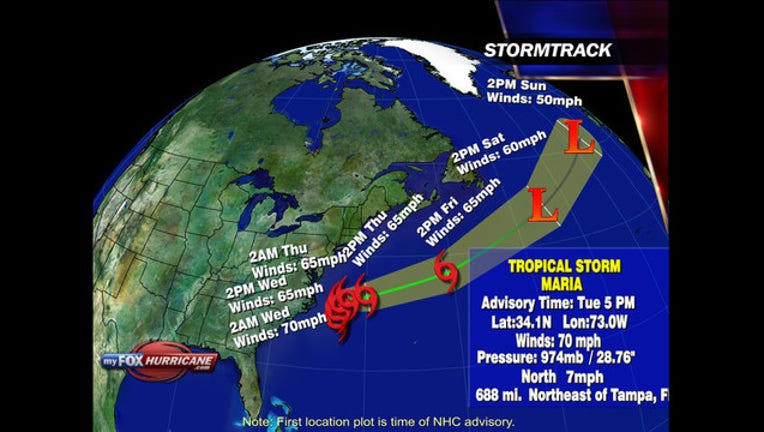Maria weakens to tropical storm near N.C. coast

WAVES, North Carolina (AP) - Thousands of visitors abandoned their beach vacations and evacuated North Carolina's Outer Banks on Tuesday as a weakening Hurricane Maria churned up high surf that pushed through dunes and under homes.
Meanwhile on Puerto Rico, more than 3.4 million U.S. citizens still lack adequate food, water and fuel five days after Maria pounded the island as a Category 4 hurricane, and officials said electrical power may not be fully restored for more than a month.
More than 10,000 visitors were told to leave the North Carolina barrier islands of Hatteras and Ocracoke, but the evacuation orders didn't apply to local residents, who are now resigning themselves to economic losses as well as more flood damage after a double pounding by last year's tropical weather.
Sarah Midgett lost her car during Hermine and her home was severely damaged by Matthew's floods. After the dunes got hit by Jose this month, Maria pushed through the weakened natural barrier on Tuesday, washing over parts of Hatteras.
"It's insane how much the beach has eroded," said Midgett, who moved many of her belongings off her floor, just in case.
In the town of Waves, kite surfing instructors lost a solid week of reservations after tourists were forced to evacuate. Adrienne Kina, who normally works as a saleswoman at REAL Watersports, says this storm "is going to screw" the locals again after a days-long power outage this summer cost sent 50,000 tourists packing and cost the Outer Banks millions in lost tourism income.
Maria's top sustained winds dropped Tuesday to near 75 mph (120 kph), and the National Hurricane Center expected it to weaken into a tropical storm by Tuesday night or Wednesday.
The center remained far offshore, centered about 175 miles (285 kilometers) southeast of Cape Hatteras, North Carolina, and moving north at 7 mph (11 kph). Still, a tropical storm warning was in effect for the North Carolina coast from Bogue Inlet to the Virginia border, and meteorologists said a storm surge could hit from Ocracoke Inlet to Cape Hatteras.
Hurricane Lee, meanwhile, was gradually strengthening far off in the open Atlantic, where it was expected to swing north and east again before tropical storm-force winds reach Bermuda.
President Donald Trump agreed Tuesday to waive the usual requirement that state governments pay a fourth of the cost of disaster aid, since Maria hit a U.S. territory already mired in financial crisis. Puerto Rico Gov. Ricardo Rossello said he's "confident the president understands the magnitude of the situation."
Federal agencies also announced how they're helping.
The Federal Highway Administration is assessing road damage to facilitate federal money to fix them. The TS Kennedy, a former commercial freighter used by the Maritime Administration for training, is moving from Texas to support recovery efforts in Puerto Rico and the U.S. Virgin Islands.
The Federal Transit Administration is helping restore ferry service, which has been available only during daylight hours to transport emergency supplies to Vieques and Culebra.
And the Federal Aviation Administration's reservation system has facilitated nearly 100 daily arrivals and departures at San Juan's Luis Munoz Marin International Airport, including military and relief operations and more than a dozen commercial passenger flights.
Because Maria destroyed or disabled critical radars and navigational aids, the FAA said it has been bringing in replacement systems by air and by sea to restore essential radar, navigation and communication services. A long-range radar in the Turks and Caicos returned to service on Monday morning, giving air traffic controllers a much better picture of planes and helicopters in the region, but technicians were still using chain saws to cut a path through a mountainous rainforest to reach and restore a second long-range radar site at Pico del Este.
In North Carolina, Dare County Emergency Management Director Drew Pearson said officials believe 10,000 to 12,500 people were leaving Hatteras, while about 500 year-round residents could stay.
Hyde County officials said they had about 700 visitors when the evacuation was ordered at Ocracoke, which has about 1,000 permanent residents.
Some of the tourists who packed up and drove off Monday had enjoyed only one day of what was supposed to be a weeklong vacation.
On Hatteras, Jay Wrenn and his wife packed up for a five-hour drive back home to Burlington, North Carolina. They had arrived at their rented cottage in Rodanthe on Sunday with a week's worth of groceries. By noon Monday, the macaroni salad they had made was in the trash.

